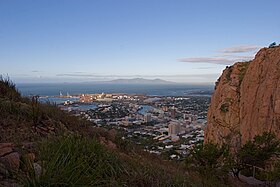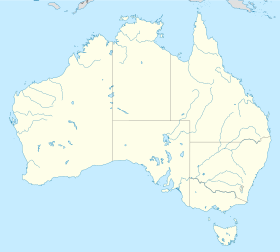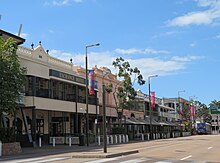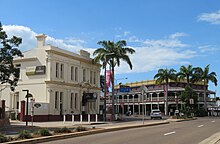Townsville
| Townsville | |||||||||
|---|---|---|---|---|---|---|---|---|---|
 Townsville from Castle Hill Overlook |
|||||||||
|
|||||||||
|
|||||||||
|
|||||||||
|
|||||||||
|
|||||||||
|
|
|||||||||
Townsville is a city of around 170,000 people in northern Queensland on the east coast of Australia .
geography
Geographical location
The city is located 1112 km northwest of Brisbane and 285 km south of Cairns , at the confluence of the short Ross River in the Pacific Ocean .
Behind Townsville, a little off the coast, stretches the Great Dividing Range .
Townsville is dominated by its local mountain, the 286 m high Castle Hill . In addition to it, there are a few more individual mountains protruding from the plain around Townsville and a reservoir on the upper and middle reaches of the Ross River.
The city is the seat of the local administrative area of the same name (LGA) Townsville City .
climate
Townsville is located in the so-called "dry tropics" (dry tropics). Scientifically, they are in the seasonally dry tropics (Engl. Wet-dry tropics ). Accordingly, the distribution of precipitation over the year is quite uneven. Of the average annual total precipitation of 1121.5 mm, over two thirds fall in the three to four month rainy season from December to March (extreme monthly amounts: 0.0 mm – 1141.7 mm). Correspondingly, of the approximately 70 to 75 annual rainy days, around 45 are in those four rainy months.
The rainy season is also the warmest time of the year. On an average January day, the air temperature fluctuates between 24.2 ° C and 31.4 ° C. On one day in July, the coldest month, the temperature alternates between 13.5 ° C and 25.0 ° C on average. The annual mean temperature is around 24 ° C to 25 ° C, the extremes between 1.1 ° C and 44.3 ° C (monthly mean of daily extremes: 13.5 ° C – 31.4 ° C; annual mean of daily extremes: 19, 8 ° C-28.8 ° C). The duration of sunshine fluctuates over the course of the year on a monthly average between 7.2 and 9.8 hours per day (annual average: 8.4 h / d).
The high temperatures cause a high potential evaporation averaging 7.2 mm per day or 2629.7 mm per year (minimum 5.0 (June); maximum 9.2 (September)). Accordingly, the humidity is not excessively high, but fluctuates between 60% in September and 75% in February (annual mean: 67%).
Occasionally, cyclones cause damage in Townsville, for the first time in 1867 and for the last time in 1971.
| TOWNSVILLE AERO - Height: 4 m from 1940 to 2009 | ||||||||||||||||||||||||||||||||||||||||||||||||
|---|---|---|---|---|---|---|---|---|---|---|---|---|---|---|---|---|---|---|---|---|---|---|---|---|---|---|---|---|---|---|---|---|---|---|---|---|---|---|---|---|---|---|---|---|---|---|---|---|
| Climate diagram | ||||||||||||||||||||||||||||||||||||||||||||||||
| ||||||||||||||||||||||||||||||||||||||||||||||||
|
Average monthly temperatures and rainfall for TOWNSVILLE AERO - Altitude: 4 m from 1940 to 2009
Source: Bureau of Meteorology ; Water temperature, humidity: wetterkontor.de
|
|||||||||||||||||||||||||||||||||||||||||||||||||||||||||||||||||||||||||||||||||||||||||||||||||||||||||||||||||||||||||||||||||||||||||||||||||||||||||||||||||||||||||||||||||||||||||||||||||||
vegetation
Mangrove forests thrive on the coast, especially near the mouths of rivers and streams (creeks) . There are also marshy open areas, which are flooded in the rainy season, dry in the dry season and, depending on the salinity of the seasonal waters, are either almost completely overgrown or overgrown by halotolerant low-growing plants or grasses.
On land, in the immediate vicinity, Townsville's tree savannas and dry forests ( woodland ) predominate - mostly low, loosely standing eucalyptus trees over a layer of grass. Fires are probably a fairly regular occurrence in these stocks.
To the north-west of Townsville, the so-called “ Wet Tropics ” begin - the humid tropics, which, like the Great Barrier Reef, have been declared a World Heritage Site by UNESCO . Not far from the city there are tropical mountain rainforests on the back of the Scheidegebirge, the southernmost of Australia is located in the mountain range of Mount Elliot a few miles southeast of the city.
In contrast to the conditions in these more humid regions, most of the inland waterways in the drier area near Townsville, including Yunbenun, have largely dried out for most of the year and sometimes for years.
history
In 1770, James Cook discovered Magnetic Island, or Yunbenun , located in front of the city , which owes its English name to the fact that the needle on the compass of his ship Endeavor was deflected in the wrong direction as it passed. Such was never observed again and the cause of that event is unclear. It could possibly have been caused by a “magnetic disturbance in the sea floor”.
At that time, Aborigines of the Wulgurukaba (= Nyawaygi) and Bindal lived in that area , as well as Warakamai (= Warrgamay), Nawagi (= Nyawaygi) and Warungu (= Gugu-Badhun).
In 1819 Phillip Parker King and Allan Cunningham explored what is now Townsville, followed by John Wickham in 1839 . In 1846 the shipwrecked James Morrill was washed up on the shores of Cleveland Bay and lived there with the Bindal for 17 years.
In 1864, John Melton Black, employed by Robert Towns , dispatched Andrew Ball, Mark Watt Reid, and a few locals to look for a place for port in the Cleveland Bay area. They found the mouth (discovered by them?) Of Ross Creek, today's Ross River, suitable. On September 5, 1864, the first settlers arrived there under the leadership of WA Ross. On August 25, 1865, the city's first child of European descent was born and named William Townsville Boyes. The city was not officially named "Townsville" until 1866, after the Sydney entrepreneur Robert Towns had agreed to provide financial support for the city's development. In the same year Townsville became a self-governing parish, which John Melton Black elected as its first mayor. Townsville had 450 inhabitants in 1867 and 1,140 in 1871.
Goldfields were discovered in the Townsville hinterland from 1867 to 1871, accelerating the city's development. In 1868 the first public school opened in Townsville. In 1876 Townsville had 1,148 women and 1,527 men. The first prison was built in 1878. Townsville received city rights in 1902.
During World War II , the city became an important location for the military to repel a possible invasion of Australia by the Japanese army . At that time there were around 70,000 soldiers stationed in and around the city, and the infrastructure was expanded for military purposes. Three air strikes, in which people were not injured and only minor damage to the fields was caused, took place with a few Japanese aircraft on Townsville: On the night of 26/26. July 1942, on the night of 26./27. July and in the night of 28/29. July 1942 The Japanese temporarily had plans to attack Townsville with 300 aircraft.
On Christmas Eve , December 24, 1971, tropical cyclone Althea struck the city and Magnetic Island, causing great damage. It was one of the most powerful tropical cyclones to hit the city of Townsville in history. Three residents died as a result of the impact, and property damage amounted to approximately 50 million Australian dollars (in 1971 prices). The international airport opened in 1981.
Buchanan's Hotel on Flinders Street, built in 1903 and judged by architectural historians to be one of the most significant buildings in the Federation Filigree style, burned down in 1982.
A peace agreement for the Solomon Islands was negotiated in Townsville in October 2000.
On the night of February 2 to 3, 2011, the center of cyclone Yasi passed Townsville north, so that there was hardly any damage to the city itself. However, electricity and water supplies were severely affected as a result of the storm.
economy
In the immediate vicinity of Townsville and further inland, towards the dry outback , the land used for agriculture is almost exclusively used for cattle breeding. In the wetter areas near the coast south and north of Townsville, however, sugar cane cultivation dominates. There are also plantings of bananas and other tropical fruits.
As far as the immediate vicinity of Townsville is concerned, forestry is more or less insignificant. Further north, in the humid tropics, there are, in addition to largely protected, primeval rainforests, for example. B. Softwood plantations.
Fishing naturally plays a role in the coastal town of Townsville, but not too much.
Due to its location, Townsville is a transshipment point not only for agricultural, but also for mining products, in particular for nickel ore from the Greenvale region and for zinc, copper, lead and silver ore from Mount Isa . In earlier times (from 1870) it was the same for gold from the nearby towns of Ravenswood and Charters Towers .
Tourism also plays an important role these days.
traffic
In terms of traffic, the city is connected to Cairns in the north and Brisbane in the south by the Bruce Highway . To the west, the Flinders Highway branches off towards Mount Isa . The construction of railway lines in the Townsville area began as early as 1879, and the first railway line to be completed was inaugurated in December 1880. A railway line has been running west from Townsville since 1929, on which the Inlander train runs to Mount Isa. Townsville is also on the Brisbane to Cairns railway line, on which the Spirit of Queensland train runs daily and also stops in Townsville. Townsville's downtown station on Flinders Street, which opened in 1913, was replaced in 2003 by a smaller new building on the outskirts.
The local airport is Townsville Airport ( IATA : TSV , ICAO : YBTL ).
There are several bus routes in the city as well as a ferry to Yunbenun ( Magnetic Island ).
Townsville Radio operates out of Townsville .
State institutions
Townsville and the surrounding area have been an important military base since World War II. There are two large military bases or restricted military areas.
Townsville is also home to a number of important scientific institutions. To be mentioned are in particular
- the James Cook University , which was founded in 1959 as a college and in 1970 elevated to the university, and where today study more than 12,000 students, including about 10% from abroad;
- the Museum of Tropical Queensland , the largest and most diverse branch of the Queensland Museum ;
- the Australian Institute of Marine Science .
architecture
In Townsville - in contrast to comparable Australian cities - numerous buildings from the 19th century and the beginning of the 20th century have been preserved. This is especially true of Flinders Street, the oldest street in the city. The most striking buildings include the former post office ( Townsville Post Office ) from 1886 at one of the city's most important intersections, whose clock tower was dismantled in 1942 and rebuilt in a modified form in 1963/64, the Tattersalls Hotel, the former Bank of New, which was built in 1864 South Wales from 1887, the Bank of Australasia built in 1905 and the Queensland Building, a commercial building built in 1890–92. Other significant buildings are the representative Australian Joint Stock Bank (1887-88), the Townsville Technical College from 1920/21, the Westpac Bank Building from 1935 and the Great Northern Hotel with its large balconies, which was completed in 1901. Opposite the Great Northern Hotel, the former train station was built in 1910–1913 and inaugurated on December 24, 1913. It was in operation until the opening of the new station on the outskirts in 2003.
One of the most distinctive churches in the city is the Roman Catholic Sacred Heart Cathedral, which can be seen from afar, on a hill above the city center, which was built in the neo-Gothic style with a gable roof in 1896-1902 . The Anglican St James' Cathedral in the city center was built in 1887-1892 and expanded in 1959-1960.
Green spaces
The 4-hectare Queens Garden, laid out from 1870 and located a little outside the center, was originally part of an approximately 40-hectare experimental farm on which tropical plants that were already known from other countries such as B. breadfruit and mahogany have been planted and examined for their usefulness in Australia.
As early as 1912 a park was laid out in the city center, which was later named Anzac Memorial Park , and at the end of 1913 the representative pavilion was built here in the middle of the park. The outdoor pool Tobruk Memorial Baths , built in the Art Deco style, was opened in 1950 in the elongated green area The Strand . Its dimensions correspond to Olympic requirements. The Strand is now the most popular park in the city. a. known for its rock pool and frequent cultural activities.
The approximately 20 hectare Anderson Park in the Muningburra district, which is best known for its tropical ferns and pandanus trees, was created from 1929, variously redesigned and got its current appearance in 1962.
Townsville Palmetum Park , in which almost all of the 60 palm species found in Australia can be seen alongside around 300 other types of plants, was opened in the south of the city in 1988 and covers an area of 17 hectares.
tourism
Townsville has The Strand, a promenade about two kilometers long, and Castle Hill , located in the urban area, offers a beautiful panoramic view of the city and the nearby islands. The Museum of Tropical Queensland and the tropical Aquarium Reef HQ with what is probably the largest aquarium coral reef in the world are located near the harbor . There is also a city and a naval museum. The at least two small art galleries with changing exhibitions may also be worth a visit. For sports enthusiasts, the city has a wide variety of options for active or passive sports. Townsville is home to the North Queensland Cowboys professional rugby league team , which competes in the national championship from approximately February to September. The stadium in the Willows Sports Complex can seat around 26,500 people.
Surroundings
The Great Barrier Reef and the islands of Magnetic Island and Hinchinbrook Island, which have largely been declared national parks , should be mentioned as nature and tourist attractions in the area . The latter is home to Australia's largest island national park, through which a multi-day hiking trail, the Thorsborne Trail , leads along the scenic east coast . Other national parks and protected areas in the vicinity of Townsville primarily protect the mountain rainforests located in them and some coastal landscapes. Immediately north of Townsville this applies to the Townsville Town Common Conservation Park and the Cape Pallarenda National Park , which are particularly worth a visit at the end of and shortly after the rainy season.
The old gold rush town of Charters Towers inland is also worth a day trip.
Town twinning
| Port Moresby , Papua New Guinea since 1983 | |
| Shunan , Japan since 1990 | |
| Iwaki City , Japan since August 1991 | |
| Changshu , People's Republic of China since 1995 | |
| Suwon , South Korea since 1996 |
sons and daughters of the town
- Julian Assange (* 1971), co-founder of WikiLeaks
- Peter Burge (* 1974), long jumper
- Natalie Cook (* 1975), beach volleyball player
- Ruth Corset (* 1977), racing cyclist
- James Hopes (born 1978), cricketer
- Mitchell Johnson , cricketer
- Luke McLean (* 1987), Italian-Australian rugby union player
- Jack Miller (* 1995), motorcycle racer
- Lisbeth Lenton (* 1985), swimmer
- Summer Lochowicz (* 1978), beach volleyball player
- Aaron Payne , rugby league player
- Ralph Douglas Kenneth Reye (1912–1977), pathologist after whom Reye's syndrome is named
- Francis Roberts Rush (1916-2001), Archbishop of Brisbane
- Madge Ryan (1919–1994), actress
- John-Patrick Smith (* 1989), tennis player
- Oliver Taylor (born 1938), boxer
- Natalie Weir (* 1967), ballet dancer and choreographer
Web links
- Townsville City Council
- Townsville InfoPortal
- Tourist information
- Townsville Bulletin (local newspaper)
- Museum of Tropical Queensland
Individual evidence
- ↑ a b Australian Bureau of Statistics : Townsville ( English ) In: 2016 Census QuickStats . June 27, 2017. Retrieved April 15, 2020.
- ↑ Climate statistics for Australian locations (TOWNSVILLE AERO). Australian Government - Bureau of Meteorology , accessed June 23, 2009 .
- ^ Trisha Fielding: Queen City of the North - a History of Townsville , p. 10. Brisbane 2016
- ↑ https://www.ozatwar.com/ozatwar/tvbomb01.htm
- ↑ https://www.ozatwar.com/ozatwar/tvbomb02.htm
- ↑ https://www.ozatwar.com/ozatwar/tvbomb03.htm
- ↑ https://www.ozatwar.com/ozatwar/tvsaved.htm
- ^ Severe Tropical Cyclone Althea. Summary. ( English ) Bureau of Meteorology . Retrieved February 2, 2011.
- ^ Praise for International Peace Team in Solomon Islands ( English ) Australian Minister for Foreign Affairs. June 25, 2002. Retrieved February 2, 2011.
- ↑ TOWNSVILLE: Lucky to dodge bullet Courier Mail, Brisbane - February 3, 2011
- ^ Trisha Fielding: Queen City of the North History of Townsville , p. 11. Brisbane 2016
- ↑ https://bugaustralia.com/item/townsville-railway-station/
- ^ Trisha Fielding: Queen City of the North - a History of Townsville , p. 9. Brisbane 2016
- ^ Trisha Fielding: Queen City of the North - a History of Townsville , p. 44. Brisbane 2016
- ↑ https://www.tsv.catholic.org.au/sacred-heart-cathedral-parish-sacred-heart-cathedral/
- ↑ http://www.soe-townsville.org/parks/queens.html
- ^ Trisha Fielding: Queen City of the North - a History of Townsville , p. 39. Brisbane 2016
- ^ Trisha Fielding: Queen City of the North - a History of Townsville , p. 88. Brisbane 2016
- ↑ http://www.soe-townsville.org/parks/strand.html
- ↑ http://www.soe-townsville.org/parks/anderson.html
- ↑ http://www.soe-townsville.org/parks/palmetum.html








